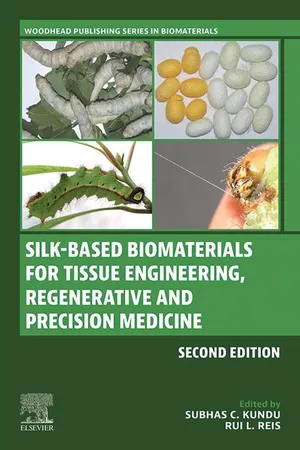
Silk-Based Biomaterials for Tissue Engineering, Regenerative and Precision Medicine
- 700 pages
- English
- ePUB (mobile friendly)
- Available on iOS & Android
Silk-Based Biomaterials for Tissue Engineering, Regenerative and Precision Medicine
About this book
Silk-based Biomaterials for Tissue Engineering, Regenerative and Precision Medicine, Second Edition is a must-have reference, providing comprehensive coverage of silk-based biomaterials and their importance in translational uses and biomedicine. This new edition considers the progress made in the past eight years, featuring many new chapters, including a discussion of cutting-edge fabrication methods and techniques, new and improved blends/composites, and an expanded range of applications in tissue engineering, regenerative and precision medicine. The book holistically reviews the types, structure and properties, processing methods, and specific biomedical applications for silk-based biomaterials.This will be a vital resource for materials and tissue engineering scientists, R&D departments in industry and academia, and academics interested in biomaterials, regenerative, and precision medicine.- Covers all key silk biomaterial types, including mulberry, Bombyx mori and nonmulberry/wild silk protein fibroins, sericins and spider silk, as well as their composite blends and various structures and scaffold platforms- Describes the cutting-edge processing techniques for each silk type, from traditional to nonconventional methods, such as using ionic liquids and engineering nanofibers and other biomedical matrices- Explores a range of applications in tissue engineering and regenerative and precision medicine, including bioprinting, bioelectronics and medical devices
Frequently asked questions
- Essential is ideal for learners and professionals who enjoy exploring a wide range of subjects. Access the Essential Library with 800,000+ trusted titles and best-sellers across business, personal growth, and the humanities. Includes unlimited reading time and Standard Read Aloud voice.
- Complete: Perfect for advanced learners and researchers needing full, unrestricted access. Unlock 1.4M+ books across hundreds of subjects, including academic and specialized titles. The Complete Plan also includes advanced features like Premium Read Aloud and Research Assistant.
Please note we cannot support devices running on iOS 13 and Android 7 or earlier. Learn more about using the app.
Information
Table of contents
- Cover
- Title page
- Table of Contents
- Copyright
- Contents
- List of contributors
- About the editors
- Foreword
- Preface
- List of Illustrations
- List of Tables
- Chapter 1 : Historical silk biomaterials
- Chapter 2 : Trends in silk biomaterials
- Chapter 3 : Processing of Bombyx mori silk biomaterials
- Chapter 4 : Nonmulberry silk-based biomaterials: biomedical applications, current status, and future perspective
- Chapter 5 : Structure and properties of spider and silkworm silks for tissue engineering and medicine
- Chapter 6 : Spider silk and blend biomaterials: recent advances and future opportunities
- Chapter 7 : Artificial silk fibers as biomaterials and their applications in biomedicine
- Chapter 8 : Engineering enzymatic- and photo-crosslinked silk-based hydrogels for regenerative medicine
- Chapter 9 : Tunable silk matrices using ionic liquids and their biomedical applications
- Chapter 10 : Silk protein–based smart hydrogels for biomedical applications
- Chapter 11 : Microfibrillated silk and its potential applications
- Chapter 12 : Vascularization in porous silk fibroin as therapeutic biomaterials
- Chapter 13 : Biodegradability of silk biomaterials
- Chapter 14 : Immune responses to silk proteins in vitro and in vivo: lessons learnt
- Chapter 15 : Recent trends in controlled drug delivery based on silk platforms
- Chapter 16 : Silk fibroin nanofibers and their blends for skin tissue engineering applications
- Chapter 17 : Three-dimensional bioprinting using silk biomaterial ink: where we are trying to move?
- Chapter 18 : Three-dimensional bioprinting of articular cartilage using silk fibroin–gelatin bioink
- Chapter 19 : Silk biomaterials for tendon and tendon-to-bone enthesis tissue engineering
- Chapter 20 : Silk for cardiac tissue engineering
- Chapter 21 : Silk scaffolds for tissue engineering in dentistry
- Chapter 22 : Silk protein: an emerging biomaterial for tumor modeling
- Chapter 23 : Cellular interaction with sericin: a basis for noncommunicable and infectious diseases
- Chapter 24 : Assembling silk into nanomedicines
- Chapter 25 : Microfluidic engineering of silk fibroin biomaterial
- Chapter 26 : Silk proteins for bioelectronic devices in healthcare
- Chapter 27 : Silk proteins toward optical and electrical devices
- Chapter 28 : Translation of a silk-based medical device from bench to bedside
- Index
- A